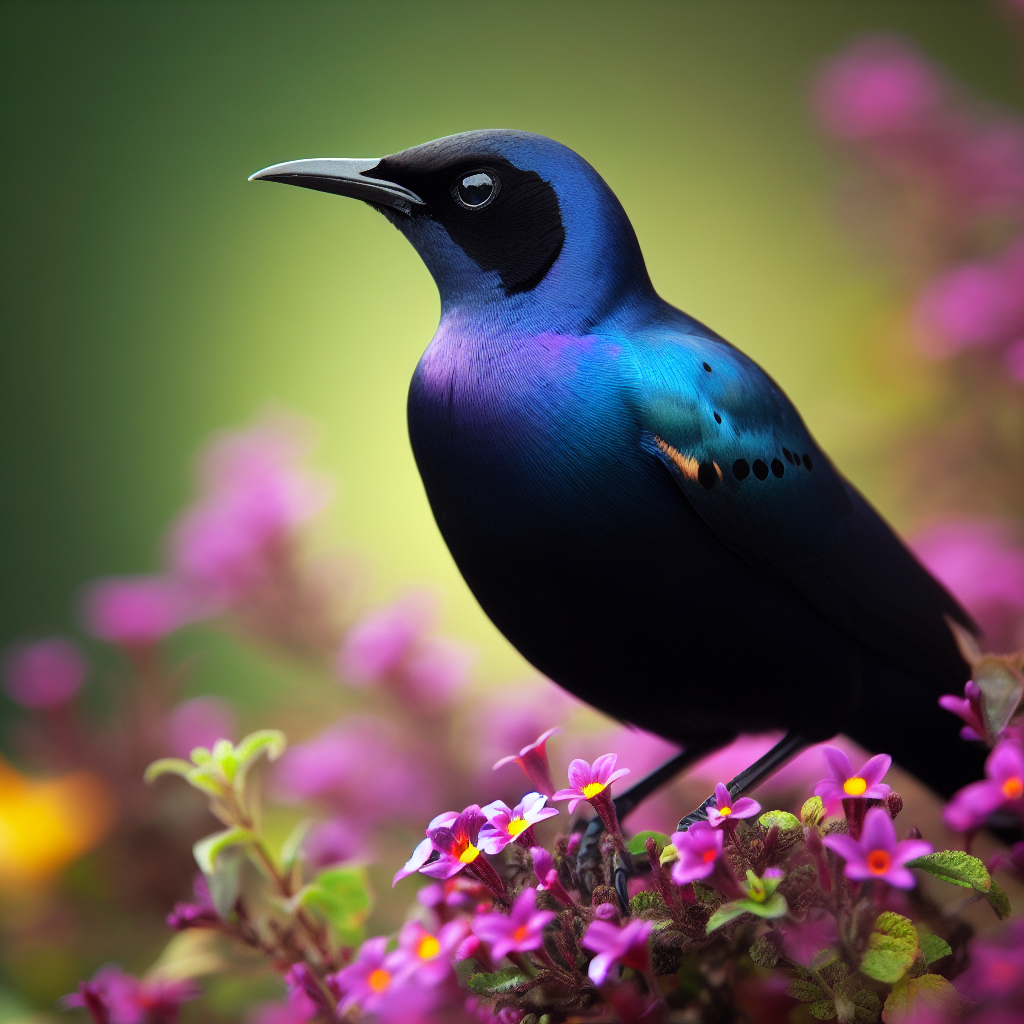Most beautiful small birds - Sykalo Eugen 2024
Violet-backed Starling (Cinnyricinclus leucogaster)
Identification:
- Species name: Violet-backed Starling
- Scientific name: Cinnyricinclus leucogaster
- Family: Sturnidae (Starlings)
- Order: Passeriformes (Songbirds)
- Subclass: Neornithes (Modern birds)
- Class: Aves (Birds)
Description:
- Size: A small starling, about 17-18 cm (6.7-7.1 in) long with a wingspan of 29-32 cm (11.4-12.6 in).
- Body shape: Slender and graceful, with a long, slightly downcurved beak, a long, rounded tail, and striking sexual dimorphism.
- Plumage color:
Males: Dazzling iridescent violet back and head, contrasting with their pure white underparts and vent.
Females: Brown upperparts with dark streaks, buff-white underparts with light streaks, and a shorter tail.
Both sexes have distinctive dark brown bills and yellow eyes.
Strong, pinkish-gray legs.
Behavior:
- Method of feeding: Omnivorous, eating fruits, berries, insects, and other small invertebrates. Often forages in pairs or small flocks.
- Reproduction: Builds cup-shaped nests in trees or rock crevices. Lays 2-4 blue eggs with dark speckles. Both parents care for the young.
- Movement: Resident in most of its range, with some local movements in response to food availability.
- Communication: Loud, clear calls and whistles, with variations used for alarm, foraging, and mating. Males have a complex song used for territorial defense and attracting mates.
Ecology:
- Habitat: Open woodlands, savannas, parks, and gardens. Prefers areas with scattered trees and access to fruit and berries.
- Diet: Fruits, berries, insects, spiders, worms, snails, and other small invertebrates.
- Hunting methods: Gleans insects from leaves and branches, pecks for hidden prey in bark crevices, and forages on the ground for fallen fruit and seeds.
Distribution: Found across sub-Saharan Africa, from Senegal to Ethiopia and south to South Africa.

The Violet-backed Starling, a feathered jewel painting the African savannas with flashes of purple and dazzling song, might seem like a simple songbird at first glance. But beneath its iridescent plumage and seemingly melodious calls lies a treasure trove of surprising facts and adaptations that will transform this savanna maestro into a captivating aerial acrobat, hidden feast master, and unexpected musical innovator in your eyes.
Masters of the Aerial Ballet: Forget clumsy hops; Violet-backed Starlings reign supreme in the domain of sun-dappled acacia trees and vast blue skies. Their powerful wings and surprisingly acrobatic skills propel them through the air with breathtaking agility, diving and looping like feathered fighter jets on miniature hang gliders. Imagine them as sky ballet dancers with built-in miniature jetpacks and an innate love for synchronized aerial performances.
Hidden Feasting Technique: Don't underestimate their dietary flexibility! While fruits and nectar are a staple, Violet-backed Starlings are opportunistic omnivores, readily adapting their menu to seasonal bounty. From juicy insects and pollen to small reptiles and even the occasional amphibian, their varied appetite keeps them fueled for energetic foraging sessions. Think of them as feathered savanna gourmands with built-in miniature buffets hidden within the thorny maze.
Singing with Improvisational Spirit: Their calls aren't just chirps and whistles. Violet-backed Starlings possess a rich and distinctive repertoire, with clear, piping songs, intricate trills, and even a signature "seeet-seeet" duet call that echoes melodically through the savanna. But their true mastery lies in their remarkable ability to incorporate sounds from their environment into their songs, including rustling leaves, buzzing insects, and even the calls of other birds. This feathered maestro, with its built-in miniature soundboard and improvisational talents, becomes a captivating DJ of the savanna, remixing the soundscape with surprising creativity.
Unexpected Musical Innovators: They're not just vocal copycats. Violet-backed Starlings are known for their unique ability to change their songs over time, adapting their melodies to match the songs of other starling populations they encounter. This feathered cultural sponge, with its built-in miniature imitation kit, becomes a living ambassador of musical trends, spreading melodies and rhythms across the vast savanna plains.
Champions of Ecosystem Health: They're not just colorful residents. Violet-backed Starlings play a vital role in the health of African savannas. Their pollination services are crucial for plant reproduction, while their insect feasting controls pest populations, making them feathered savanna doctors with built-in miniature pollen-spreading tools and environmental beautification kits.
Cultural Charmers: Across Africa, the Violet-backed Starling has held diverse cultural significance. In some regions, its iridescent plumage inspires admiration for its beauty and vibrancy. In others, its playful spirit and musical prowess are seen as symbols of joy and celebration.
Unexpected Regional Variations: Did you know? Not all Violet-backed Starlings are the same! Different populations across their vast range show subtle variations in plumage color and call patterns, adding a touch of feathered diversity to this adaptable species.